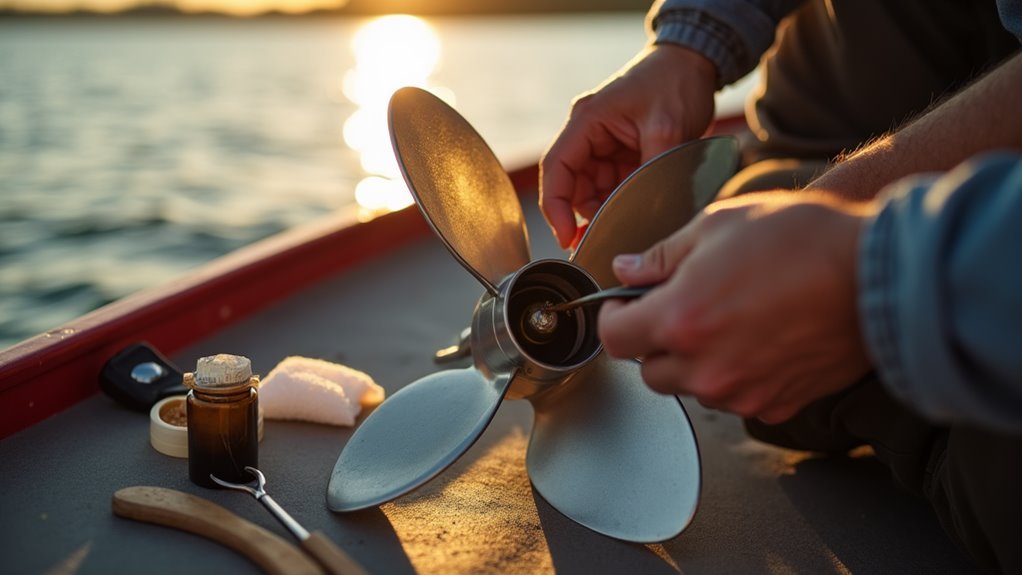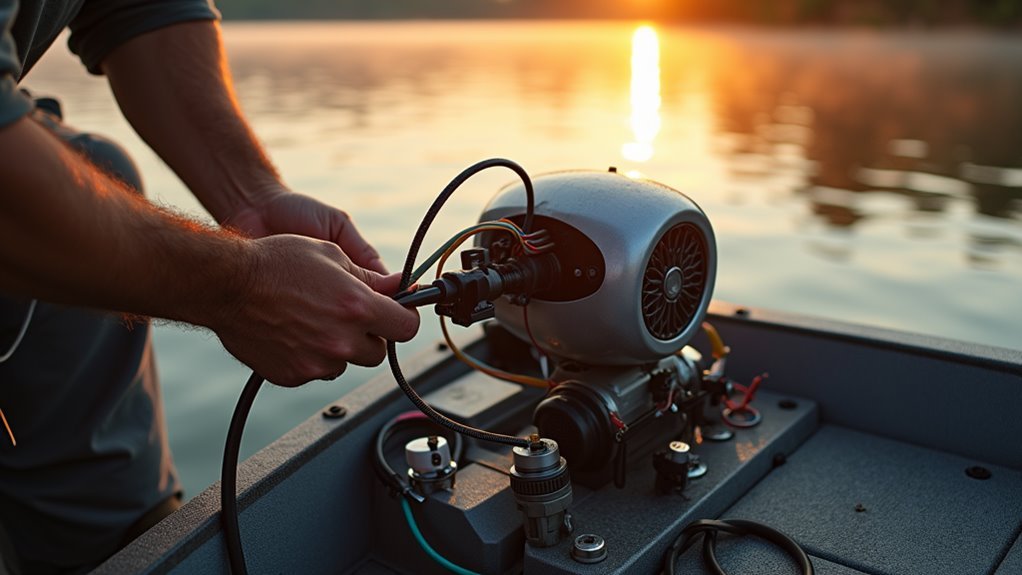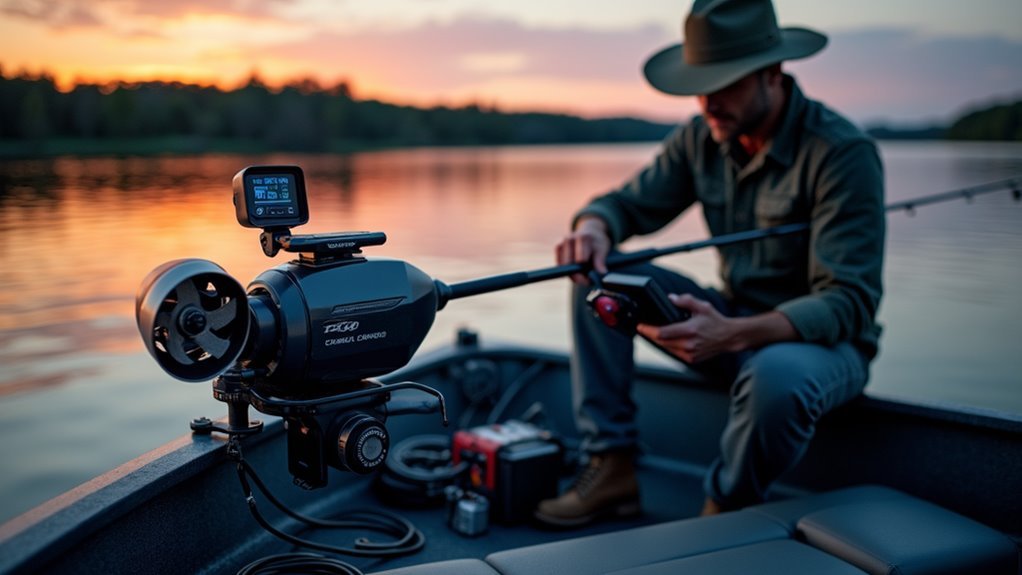When we're planning longer fishing trips, it's essential we focus on getting the most out of our trolling motors. We've got to think about more than just turning it on and casting our line. From choosing the right battery and maintaining the propeller to fine-tuning speed settings, several factors play a vital role in efficiency. Don't forget, regular checks on wiring and connections can make a big difference. Smart charging practices can also extend our motor's run time. So, how can we put all these strategies into practice for our next outing? There's more to cover.
Optimize Battery Selection
When optimizing battery size for trolling motors, understanding the different types of batteries is crucial. We must consider options like lead-acid, AGM, and LiFePO4. Each has unique benefits, and selecting the right one can boost our freedom on the water.
Lead-acid batteries are heavier and require maintenance, impacting battery weight and maintenance costs. AGM batteries offer reliable power without maintenance hassles, though they're heavier and costlier. LiFePO4 batteries, known for their high energy density, provide a lightweight, long-lasting option with advanced safety features.
Battery capacity and voltage alignment are key. Capacity dictates how long we can run our motor, while voltage alignment guarantees our motor's efficiency—12V for smaller motors and 24V or 36V for more power.
Let's not forget group size; larger sizes impact run time and deep discharge capabilities. Long term savings are achieved with batteries that handle charge cycles efficiently, making them a wise choice.
Ultimately, our battery doesn't just power our trolling motor; it fuels our adventures. By understanding these factors, we can enjoy longer, carefree days exploring open waters. Battery choice is our ticket to freedom.
Maintain Proper Propeller Care

Selecting the right battery is just the first step in enhancing our trolling motor's performance; maintaining proper propeller care guarantees it operates at its best. To keep our motor running smoothly, we start with regular propeller cleaning.
By removing debris, we prevent power loss and motor degradation. A 1/2" socket and ratchet helps us loosen the propeller nut, making it easy to clean behind it and remove troublesome grass or fishing line. Wiping everything down with a soft cloth confirms our propeller stays spotless and efficient.
Propeller cleaning is often an overlooked part of trolling motor maintenance, but regularly removing gunk and garbage can significantly extend the motor's lifespan.
But that's not all. Let's not forget about propeller drive pin inspection. Regularly inspecting the drive pin using a 9/16" socket keeps our propeller functioning properly.
We look for wear or corrosion and apply drive pin lubrication to avoid rust and confirm smooth operation. This effort extends the life of our motor substantially.
Propeller alignment plays a vital role too in efficient performance. Checking its alignment regularly helps us avoid unnecessary wear.
Sometimes, a few adjustments or switching to a weedless prop makes a huge difference. These careful steps confirm our fishing trips are long and free, without motor hiccups.
Implement Efficient Speed Settings

How can we make the most out of our trolling motor while guaranteeing we don't cut our fishing trips short? The secret lies in smart Speed Management and Thrust Optimization. By simply lowering our speed settings, we can greatly extend our battery life.
Running our motors at full speed drains them quickly, cutting our adventures down to nothing. But by choosing a steady, slower pace, we'll not only save power but have better control as well.
Understanding the link between speed and thrust is crucial. Higher thrust means more power consumption, so finding the right balance is key. We should match our speed to the fishing conditions. Direct modification of low-speed settings through the motor's sealed control device is not practical; however, using an external rheostat or pulse width modulation controller can achieve desired speed control.
Trying to catch bass? Speeding isn't helpful. Instead, we should fine-tune our approach for greater efficiency.
With advances in trolling motor technology, like regulators that break electric current into smaller parts, we can achieve efficient speed settings. These tools guarantee that each battery charge lasts longer.
Taking time to adjust speeds based on conditions or boat load can make our fishing experience even better. Let's embrace this knowledge to manage our speed efficiently and optimize thrust, making every fishing trip an enduring exploration.
Regularly Inspect Wiring and Connections

A well-maintained trolling motor guarantees efficient performance, and that starts with regularly inspecting wiring and connections. When we're out on the open water, free from the hustle of daily life, we don't want unexpected problems sneaking up on us.
Corrosion prevention is key—regularly inspect those battery terminals and connections for any signs of rust or gunk. A battery wire brush works wonders to clear that all away. It's simple but essential in keeping power flowing smoothly.
Let's not forget about the wiring itself. We should examine it for any frays or damage, as these can sneakily reduce power flow. If any damage is found, replacing the wiring can save us headaches later. Batteries lose power over time if unused, significantly affecting the trolling motor's performance.
Connection tightening is another critical step; ensuring every connection is secure keeps voltage steady, preventing drops that might leave us stranded. A little twist and turn make a big impact!
Finally, keeping an eye on the voltage at different points helps us uncover hidden power issues. Using a voltmeter can quickly point out if things aren't as they should be. Together, these practices keep our equipment performing at its best, letting us savor every moment of our fishing trips.
Utilize Smart Charging Practices

Smart charging practices are the backbone of efficient and dependable trolling motor operations. We all want the freedom of longer fishing trips without worrying about running out of juice.
To achieve this, we need to pay attention to the steps that guarantee our trolling motors perform at their best.
- Choose the Right Charger: It's crucial to select a charger that matches our battery chemistry—whether it's lead-acid, AGM, gel, or lithium-ion. Plus, a smart charger with temperature compensation helps keep everything in balance, even when the weather gets chilly.
- Maintain the Charger: Regular charger maintenance guarantees it's functioning correctly. By checking for wear or damage, we make sure the charger is ready for action when needed. Trolling motor batteries can withstand deep discharges, meaning they can be completely drained and recharged without significant damage, making them ideal for those long days on the water.
- Practice Safe Charging: Charging in a well-ventilated area is safer and helps prevent overheating. And, it's always smart to use safety gear like goggles and gloves.
- Employ Efficient Charging Methods: Consider using high-output solar panels, onboard chargers, or portable chargers for convenience and longer running times.
With these smart practices, we're set for more adventure on the water, free from the hassle of unexpected power shortages. So let's gear up and enjoy every moment of our fishing trips.
Frequently Asked Questions
How Do Weather Conditions Affect Trolling Motor Efficiency and Battery Life?
It is clear that weather conditions affect our trolling motor's efficiency. Strong wind resistance and water temperature changes impact performance. Increased current strength, air pressure shifts, and wave impact can drain battery life, reducing our time exploring freely.
What Are the Best Practices for Minimizing Trolling Motor Noise?
We can embrace freedom on the water by minimizing trolling motor noise through refined propeller design and strategic mounting techniques. Let's separate cables, upgrade components, and optimize propulsion for a tranquil and efficient fishing experience.
How Can I Determine the Ideal Thrust Level for My Boat Size?
Let's use a thrust calculator to find the ideal thrust for our boat's weight. Accurately assess boat weight, including gear and passengers, for a perfect balance between power and freedom on the open water. Enjoy your adventure!
Do Hull Designs Impact Trolling Motor Run Times Significantly?
A stitch in time saves nine—our hull shape and hydrodynamics do impact trolling motor run times. By optimizing these factors, we'll experience smoother navigation, conserve energy, and enhance our freedom on the water for extended fishing adventures.
Are There Alternative Energy Sources to Traditional Trolling Motor Batteries?
Sure, we can explore alternative energy sources for trolling motors. Solar panels and wind turbines offer renewable options, providing freedom from traditional batteries. They're silent and eco-friendly but require careful planning and space to be effective.
Conclusion
So there we have it, folks! We're on a mission to transform our fishing escapades into epic adventures that'd make Poseidon envious. By choosing the best batteries, keeping our props in tip-top shape, and controlling our speed like racing pros, we're not just fishing—we're optimizing. Don't forget to keep an eye on our wires and become masters of smart charging. Let's keep trolling efficiently and make those fishing tales as endless as our newfound battery life! 🎣